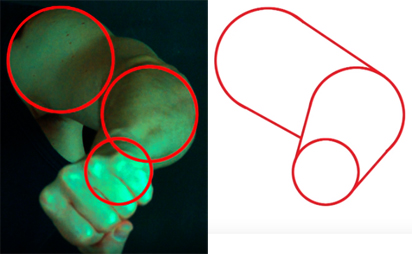

Ladies Nights, Gentleman's evenings, Office, Charity and Leaving functions. Last minute bookings.
How to master foreshortening in life drawing
Foreshortening occurs when viewing the body at extreme perspectives and is often the most challenging part of life drawing.
The best technique to handle a perspective life drawing with foreshortening is to view different parts of the body as cylinders. For example start at the connecting joints of the arms and draw circles approximately the width of each joint as seen in the picture below, which will represent the ends of the cylinders. Then draw lines connecting the circles which will give it a base for the size and shape of the limbs which can then be rendered. You can then add shading to add a more realistic rendering. This technique also works if the arms are receding from the viewer. It also works well for hands and fingers.

When the body is foreshortened the body appears compressed, obscured or hidden and the sizes are distorted. For example the hand appears much larger when extended towards the artist.
There are three aspects of foreshortening that should be considered to help improve the drawing.
(1) Overlapping
Overlapping shapes is a great way to create an illusion of depth. One object placed behind another which overlaps yet another immediately conveys a sense of space. Separating shapes can be done using contour lines or shading keeping one form in front of another. While overlapping helps you separate the forms you have to remember they are still connected, so it's a fine line between separating the shapes while still keeping them flowing from one to another.
(2) Interconnectivity
Bones, muscles and tendons are connected and as artists you can visually emphasize these to suit a purpose, for example the line of the ankle emphasizes the joining of the foot and the leg.
(3) Shading
Shading can add emphasys to foreshortening for example a shadow might be darker the closer the figure's limb is to the artist and gradually grows lighter further away. Or the entire figure can go from dark to light from the feet going to the head at certain angles.